Ultra-Wideband (UWB) Planar Monopole Antennas
This example shows how to design UWB planar monopole antennas. Planar monopole antennas are simple in geometry and provide an ultra-wideband (UWB) operating bandwidth. To create a planar monopole, replace a conventional wire monopole with planar elements in a variety of shapes to increase the surface area of the monopole. To design a planar monopole antenna, mount a planar metal plate on the ground plane. The ground plane can also have various shapes.
Annular Planar Monopole Antenna
This figure shows the geometry and dimensions of an annular planar monopole antenna. The radiating element is an annular ring, with an outer radius (rBig) of 25 mm and an inner radius (rSmall) of 10 mm, located vertically above a square ground plane with a side length of 305 mm. The feed gap (d)between the feed point in the radiator and the ground plane and the width of the feed strip (w) are set to 0.8 mm and 0.6 mm, respectively, to enhance the impedance bandwidth. The offset value is set to 0.2 mm to make a perfect connection between the feed strip and the annular ring radiator.

Create Ground Plane
Create the square ground plane with a side length of 305 mm using the antenna.Rectangle function.
Lg = 305e-3; Wg = 305e-3; groundPlane = antenna.Rectangle(Length=Lg, Width=Wg);
Create Radiator
Create the feed strip using the antenna.Rectangle function. To create an outer and inner circle, use the antenna.Circle function. To create the annular ring radiator, subtract the innerCircle from the outerCircle and add in the FeedStrip.
d = 0.8e-3;
w = 0.6e-3;
offset = 0.2e-3; % offset value when a vertex touches the feed.
FeedStrip = antenna.Rectangle(Length=w,Width=d,Center=[0 d/2]);
rBig = 25e-3;
rSmall = 10e-3;
outerCircle = antenna.Circle(Radius=rBig,Center=[0 rBig+d-offset]);
innerCircle = antenna.Circle(Radius=rSmall,Center=[0 rBig+d-offset]);
radiator = outerCircle - innerCircle + FeedStrip;Create Planar Monopole
To create the annular ring planar monopole antenna, use the monopoleCustom object.
ant = monopoleCustom(Radiator=radiator,GroundPlane=groundPlane); show(ant)
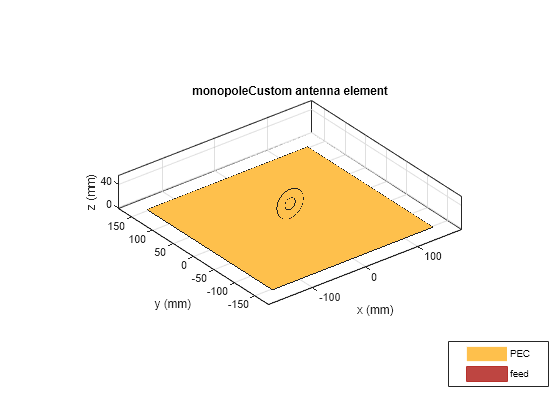
Generate Antenna Mesh
Mesh the antenna manually by using at least 10 elements per wavelength at 3 GHz before running the analysis. Set the MaxEdgeLength to lambda/10.
figure mesh(ant,MaxEdgeLength=0.01)

Calculate VSWR
Calculate the voltage standing wave ratio (VSWR) of the annular ring planar monopole antenna to find the impedance bandwidth of the antenna. The VSWR is less than 2 in the frequency range of 1.2 GHz to 8.7 GHz.
figure vswr(ant,(0.5:0.2:10)*1e9,50); ylim([1 5]);
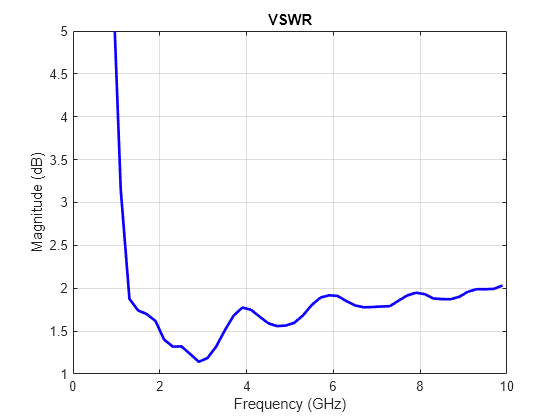
Plot Antenna Radiation Pattern
Analyze the radiation pattern of the antenna is at 4 GHz.
figure pattern(ant,4e9);

At 4 GHz, the annular ring monopole antenna exhibits typical omnidirectional monoplanar radiation pattern with a maximum gain of around 6 dBi. The simulation results agree with the results presented in [1].
Square Planar Monopole Antenna with Trident-Shaped Feeding Strip
This figure shows the geometry and dimensions of a square planar antenna with the square plane has a side length of 34 mm. The trident-shaped feeding strip parameters are: distance between the ground plane and the feeding strip (d) is 1 mm, height of the feeding strip from d (h) is 4 mm, the horizontal length of the feeding strip (t) is 18 mm, and the width (w) of all the three strips that make the trident is 2 mm. The radius of the ground plane (R) is 150 mm. The idea of the trident-fed square monopole is taken from [2], but in this example uses a circular ground plane.
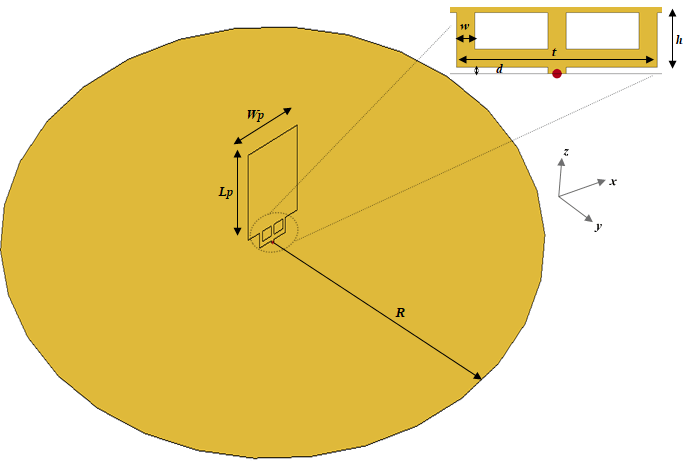
Create Radiator
The radiator comprises of a trident-shaped feeding strip and square monopole. Create the trident-shaped feeding strip object, Feed, by adding the Strip1, Strip2, Strip3, Strip4 and Strip5 shapes. To create radiator, add the Feed with monopole shape.

Lp = 34e-3; Wp = 34e-3; h = 4e-3; d = 1e-3; w = 2e-3; t = 18e-3; Strip1 = antenna.Rectangle(Length=w, Width=d, Center=[0 d/2]); Strip2 = antenna.Rectangle(Length=t, Width=w, Center=[0 d+w/2]); Strip3 = antenna.Rectangle(Length=w, Width=h, Center=[-(t/2-w/2) d+w+h/2]); Strip4 = antenna.Rectangle(Length=w, Width=h, Center=[0 d+w+h/2]); Strip5 = antenna.Rectangle(Length=w, Width=h, Center=[t/2-w/2 d+w+h/2]); Feed = Strip1 + Strip2 + Strip3 + Strip4 + Strip5; monopole = antenna.Rectangle(Length=Lp, Width=Wp, Center=[0 d+w+h+Wp/2]); radiator = Feed + monopole;
Create Ground Plane
Create the circular ground plane using the antenna.Circle function with radius of 150 mm.
R = 150e-3; groundPlane = antenna.Circle(Radius=R);
Create Planar Monopole
To create a trident-fed square planar monopole antenna, use the monopoleCustom object.
ant = monopoleCustom(Radiator=radiator,GroundPlane=groundPlane); show(ant)
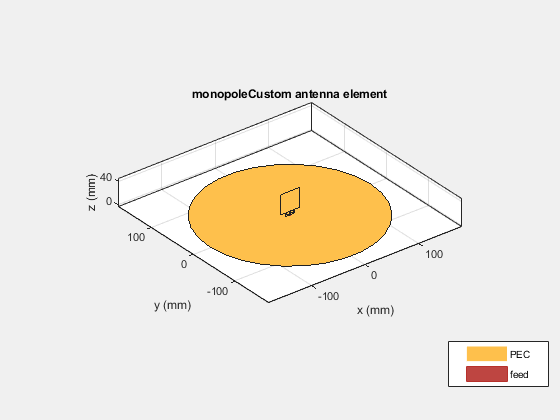
Generate Antenna Mesh
Mesh the antenna manually by using at least 10 elements per wavelength at 4 GHz before running the analysis. Set the MaxEdgeLength to lambda/10.
figure mesh(ant,MaxEdgeLength=0.0075);

Calculate Reflection Coefficient
Calculate the reflection coefficient of the planar monopole antenna to find the impedance bandwidth of the antenna. The reflection coefficient is less than -10 dB in the frequency range 1.6 GHz to 9.3 GHz.
freq = (1:0.2:10)*1e9;
s = sparameters(ant,freq);
figure
rfplot(s);
title("Reflection Coefficient");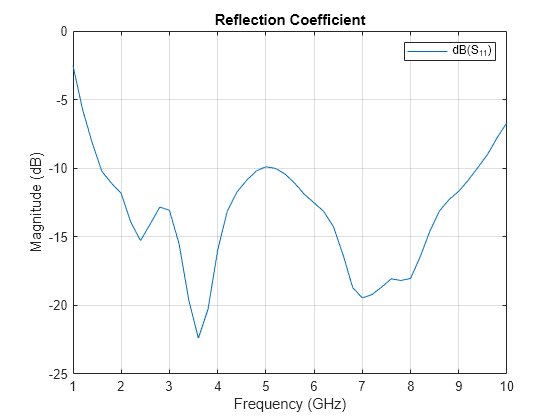
Plot Radiation Pattern
Analyzing the radiation pattern of the antenna at 2 GHz, 6 GHz, and 9 GHz shows the vertical polarization as stable in the entire range of frequencies. But as the frequency increases, there is an increase in the horizontal polarization component.
pV_1 = pattern (ant, 2e9, 0, 0:1:360, Polarization="V"); pH_1 = pattern (ant, 2e9, 0, 0:1:360, Polarization="H"); figure polarpattern(pV_1, MagnitudeLim=[-150 20]); hold on; polarpattern(pH_1, MagnitudeLim=[-150 20]); legend VerticalPolarization HorizontalPolarization;
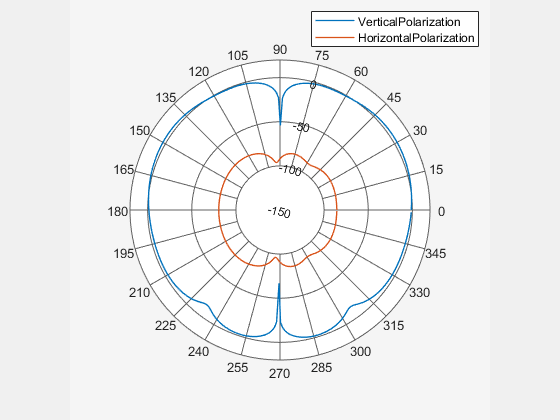
pV_2=pattern (ant, 6e9, 0, 0:1:360, Polarization="V"); pH_2=pattern (ant, 6e9, 0, 0:1:360, Polarization="H"); figure; polarpattern(pV_2, MagnitudeLim=[-150 20]); hold on; polarpattern(pH_2, MagnitudeLim=[-150 20]); legend VerticalPolarization HorizontalPolarization;
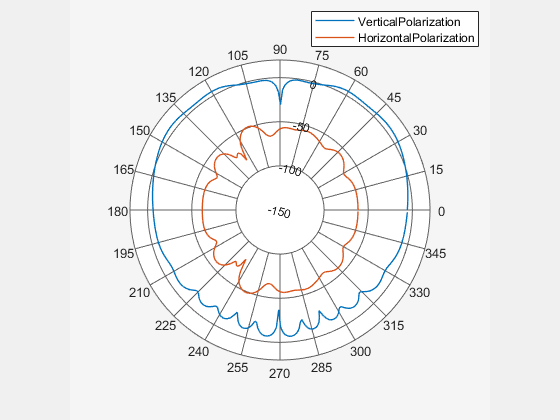
pV_3 = pattern (ant, 9e9, 0, 0:1:360, Polarization="V"); pH_3 = pattern (ant, 9e9, 0, 0:1:360, Polarization="H"); figure polarpattern(pV_3, MagnitudeLim=[-150 20]); hold on; polarpattern(pH_3, MagnitudeLim=[-150 20]); legend VerticalPolarization HorizontalPolarization;
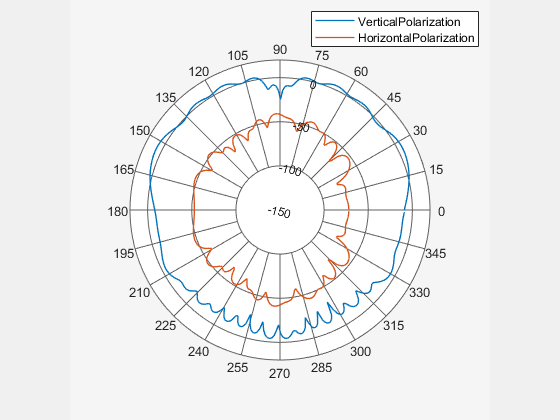
View Current Distribution
The current distribution of the antenna is analyzed at 2.5 GHz. The trident-shaped feeding structure results in uniform current distribution in the lower part of the square monopole.
current(ant,2.5e9,Scale="log");
view(0,1)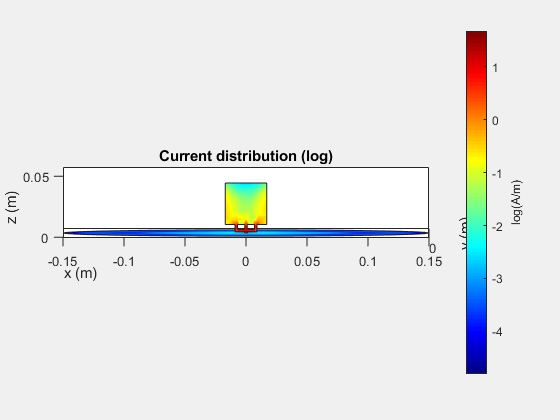
Conclusion
Planar monopole antennas have simple geometry, and you can define their radiators and the ground planes in variety of different shapes. These antennas offer ultra-wide impedance bandwidth with an azimuthal radiation pattern that is nearly omnidirectional.
Reference
[1] Chia, M.Y.W., Z.N. Chen, T.S.P. See, and M.J. Ammann. “Annular Planar Monopole Antennas.” IEE Proceedings - Microwaves, Antennas and Propagation 149, no. 4 (August 1, 2002): 200–203. https://doi.org/10.1049/ip-map:20020701.
[2] Kin-Lu Wong, Chih-Hsien Wu and Saou-Wen Su, "Ultrawide-band square planar metal-plate monopole antenna with a trident-shaped feeding strip," IEEE Transactions on Antennas and Propagation, Vol. 53, No. 4, April 2005, pp. 1262-1269.
